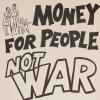For those of you who’ve never heard his name, Saul Alinsky was a highly skilled community organizer and political activist who found notoriety through his work improving the conditions of poor communities across the United States during the 1950’s and 60’s. His methodologies gained enormous results and were adapted by many college students and “counter-culture” organizers during the social and political unrest of the 1960’s. His tactics were so new and radical that in 1966, conservative author William F. Buckley Jr. said that Alinsky was “very close to being an organizational genius.” And in 1970, Time magazine wrote that “it is not too much to argue that American democracy is being altered by Alinsky.” He eventually published his book “Rules for Radicals” in 1971, which has since become a blueprint for many social and political activist groups that have followed.
But at the core of Alinsky’s “Rules for Radicals” is his belief that morals and ethics are nothing more than impediments to the social or political success one is attempting to obtain. Alinsky’s mission was to incite constant struggle and agitation so that the “oppressive system” (social, political, commercial, industrial, etc.) would eventually be brought to its knees. The goal then, of Alinsky's method is simply destruction - destruction of the "system" whatever it may be. There is, however, little discussion from Alinsky of what is to replace this system once it is brought down. So, fundamentally, the struggle to get power is the essence of his tactics, but what to do with the power once it’s acquired is another matter altogether.
So, taken from his book, here are Alinsky’s “rules” in brief:
RULE 1: “Power is not only what you have, but what the enemy thinks you have." Power is derived from 2 main sources – money and people. “Have-Nots” must build power from flesh and blood. (These are two things of which there is a plentiful supply. Government and corporations always have a difficult time appealing to people, and usually do so almost exclusively with economic arguments.
RULE 2: “Never go outside the expertise of your people.” It results in confusion, fear and retreat. Feeling secure adds to the backbone of anyone. (Organizations under attack wonder why radicals don’t address the “real” issues. This is why. They avoid things with which they have no knowledge.)
RULE 3: “Whenever possible, go outside the expertise of the enemy.” Look for ways to increase insecurity, anxiety and uncertainty. (This happens all the time. Watch how many organizations under attack are blind-sided by seemingly irrelevant arguments that they are then forced to address.)
RULE 4: “Make the enemy live up to its own book of rules.” If the rule is that every letter gets a reply, send 30,000 letters. You can kill them with this because no one can possibly obey all of their own rules. (This is a serious rule. The besieged entity’s very credibility and reputation is at stake, because if activists catch it lying or not living up to its commitments, they can continue to chip away at the damage.)
RULE 5: “Ridicule is man’s most potent weapon.” There is no defense. It’s irrational. It’s infuriating. It also works as a key pressure point to force the enemy into concessions. (Pretty crude, rude and mean, huh? You want to create anger and fear.)
RULE 6: “A good tactic is one your people enjoy.” They’ll keep doing it without urging and come back to do more. They’re doing their thing, and will even suggest better ones. (Radical activists, in this sense, are no different than any other human being. We all avoid “un-fun” activities, and but we revel at and enjoy the ones that work and bring results.)
RULE 7: “A tactic that drags on too long becomes a drag.” Don’t become old news. (Even radical activists get bored. So to keep them excited and involved, organizers are constantly coming up with new tactics.)
RULE 8: “Keep the pressure on. Never let up.” Keep trying new things to keep the opposition off balance. As the opposition masters one approach, hit them from the flank with something new. (Attack, attack, attack from all sides, never giving the reeling organization a chance to rest, regroup, recover and re-strategize.)
RULE 9: “The threat is usually more terrifying than the thing itself.” Imagination and ego can dream up many more consequences than any activist. (Perception is reality. Large organizations always prepare a worst-case scenario, something that may be furthest from the activists’ minds. The upshot is that the organization will expend enormous time and energy, creating in its own collective mind the direst of conclusions. The possibilities can easily poison the mind and result in demoralization.)
RULE 10: “If you push a negative hard enough, it will push through and become a positive.” Violence from the other side can win the public to your side because the public sympathizes with the underdog. (Unions used this tactic. Peaceful [albeit loud] demonstrations during the heyday of unions in the early to mid-20th Century incurred management’s wrath, often in the form of violence that eventually brought public sympathy to their side.)
RULE 11: “The price of a successful attack is a constructive alternative.” Never let the enemy score points because you’re caught without a solution to the problem. (Old saw: If you’re not part of the solution, you’re part of the problem. Activist organizations have an agenda, and their strategy is to hold a place at the table, to be given a forum to wield their power. So, they have to have a compromise solution.)
RULE 12: "Pick the target, freeze it, personalize it, and polarize it.” Cut off the support network and isolate the target from sympathy. Go after people and not institutions; people hurt faster than institutions. (This is cruel, but very effective. Direct, personalized criticism and ridicule works.)
"The act of simultaneously accepting two mutually contradictory beliefs as correct"
As you read through these rules, I trust you began to recognize elements of Alinsky’s tactics in our present day political figures and social activists.
Take a look at Rule 1. How many times have you seen a political or social activist on the news shouting about how they are defending “their” people, or “their” constituency? Or how many times you’ve been told about a protest of “thousands” only to find out it was a protest of HUNDREDS? The constant exaggeration of “their” numbers by politicians and social activists (constantly parroted by the media) gives the impression that the issue (whatever it is) has a larger following than it really does and therefore must be given more importance (and urgency) than it really warrants. And with multiple groups doing this, the amount of time it would take to confirm their numeric claims is too time consuming, and means that 30-second sound-bite for the evening news won’t be ready. So no one investigates . . . we get the 30-second sound-bite . . . and we’re forced to either take them at their word, or be constantly skeptical.
Rules 2 and 3 go together, it just depends on which side of the issue you happen to be on at the time. But you should easily recognize these tactics when watching a political debate nowadays. Why is it that a question asked of politician gets turned into an answer about something completely different? Because the political landscape has embraced these two rules wholeheartedly. No one argues the real issue anymore. All they do is verbally joust with moderators and each other looking for that one irrelevant “nugget” that makes them look like they got the upper hand.
Rule 5 is the all-time classic! The opponent is the “enemy,” “a racist,” “a bigot,” “ignorant,” “a homophobe,” “sexist,” “intolerant,” “prejudice,” “neo-Fascist,” “a hypocrite,” “disgusting,” “corrupt,” “a killer,” “a narcissist,” and “Hitler.” Name-calling has always been part of any political debate and election. But over the past couple of decades this tactic has become increasingly worse and more prevalent than ever. And it has also spilled over into our social and cultural disagreements. Ever notice that social activists use this strategy on a regular basis now? It’s no longer about the merits of the issues themselves - it’s about making your opponent look bad in the public eye.
Rules 9 and 12 are really kind of an offshoot of Rule 5. The “threat” can be not only for your opponent, but for those observing the argument as well. Any member of the audience that has a hot-button issue in their lives (making them receptive to any of the random slurs based on Rule 5) may become swayed by those remarks and begin to see your opponent as a threat to their own well-being. So, not only can your opponent be put on the defensive because your threat appears viable and horrific, but you may even gain unintended support from observers because of their susceptibility to a particular slur you’ve laid at the feet of your opponent. This has become commonplace in almost every avenue of our society. How many times have you watched an argument over an issue turn into a name-calling tirade by one (or both) participants? By personalizing the argument, you get the opponent off-track and defensive. Eventually, they may start attacking you back in a similar fashion, and in doing so, reveal a side of themselves that elicits sympathy from onlookers toward you.
Rule 10 is almost Orwellian. In Orwell’s book “1984” he introduces the term “doublethink,” which is the act of simultaneously accepting two mutually contradictory beliefs as correct. Doublethink is notable due to a lack of cognitive dissonance — thus the person is completely unaware of any conflict or contradiction. In other words, the distinctions of “good and evil,” or “right and wrong” become blurred, allowing the ruling powers to manipulate the public through the use of a constantly shifting vocabulary whose goal is to eradicate synonyms, antonyms, and undesirable concepts. Simply stated, “right is wrong, wrong is right, good is bad, and bad is good.” Ultimately, if you can’t discern the merits (or inaccuracies) of someone’s argument, you become susceptible to their passion, or even the fear they elicit.
"History is like a relay race of revolutions"
Here is a tidbit from Alinsky’s last interview (given in 1972 to Playboy magazine) that should give you a sense of his motivation. "History is like a relay race of revolutions; the torch of idealism is carried by one group of revolutionaries until it too becomes an establishment, and then the torch is snatched up and carried on the next leg of the race by a new generation of revolutionaries. The cycle goes on and on, and along the way the values of humanism and social justice the rebels champion take shape and change and are slowly implanted in the minds of all men even as their advocates falter and succumb to the materialistic decadence of the prevailing status quo."
So, there appear to be no absolutes for Alinsky that can be passed from one generation to the next. There is no “historical context” which one generation can use to learn from a previous one. He sees values based on humanism and social justice as ever changing and yielding to the status quo of each generation. He views existing institutions as illegitimate and therefore they must be deconstructed. This is the epitome of “the end justifying the means.” In this worldview, life is simply a series of ongoing battles for the purpose of getting what you want when you want it. There are no rules. There are no boundaries. Step on whoever you need to step on. Berate, lie, threaten, steal, and break existing laws. It doesn’t matter because it will all change once the next generation has trampled over your grave as it moves on toward a new status quo.
It’s pretty obvious that Alinsky had figured out how to win the fights - tap into peoples’ emotions on a visceral level. But what he completely ignored was what to do after the fight was won. During his last interview he stated: “We'll start with specific issues - taxes, jobs, consumer problems, pollution - and from there move on to the larger issues: pollution in the Pentagon and the Congress and the board rooms of the mega-corporations. Once you organize people, they'll keep advancing from issue to issue toward the ultimate objective: people power."
And again: "All life is warfare, and it's the continuing fight against the status quo that revitalizes society, stimulates new values and gives man renewed hope of eventual progress. The struggle itself is the victory." Alinsky’s “goal” was really just the battle itself! And the more emotionally charged he could make it, the better.
Aristotle said: “It is not enough to win a war; it is more important to organize the peace.” Though Alinsky’s tactics may help his disciples triumph in their various battles for power and position, once they’ve won those battles they have no guidelines as to what to do next - short of looking for another battle to fight. Which is what many of them do.
Unfortunately for our society, we have droves of politicians, professors, activists, lawyers, militants, radicals (on both sides), and lobbyists who either sat at the feet of Alinsky himself, or were mentored by those who did. And the long-term fallout of that has become a fractured political culture and an antagonistic society.
"It plays to our very basest nature"
Various polls have shown that confidence in our government is at an all-time low, with many citizens complaining of politicians being an elitist group who care only about their own interests. Every national election feels more and more like we’re choosing between the lesser of two evils. Despite all this, politicians continue to behave like it’s a schoolyard fight instead of discussing the issues that plague our citizenship. They are so entrenched in Alinsky’s tactics that they dare not deviate lest they risk losing the vote. In turn, our society has become so used to these tactics that it’s what we expect, and when we don’t get it from a political or social leader we view them as soft (“they can’t meet the fight”).
The media rides on the coattails of this reality for nothing more than ratings - yes, “ratings” are still more important to them than any political leanings. The nightly news is fraught with 30-second sound bites (made to appear as controversial as possible) from politicians and social leaders - the sole purpose of which is to garner our viewership. As leaders learned they could gain traction with these tactics (and the media realized they could increase ratings by offering sound bites from these tactics) the entire cycle expanded geometrically to the point that it has become engrained into the fabric of our society.
The problem is that Alinsky’s rules play to our very basest nature. A quick glance of politically based Facebook postings reveals them to be rampant with posts that have become personal attacks between people who know nothing about one another. There is rarely any discussion about the merits of ones’ vantage point, but rather the unleashing of accusations, condescending remarks and vial slurs that have little to do with the original topic. Even comments posted on Sports websites degenerate into name-calling. Worse yet, it takes no time at all for people to take sides and gang up on individuals making statements the larger group doesn’t agree with - even if it’s nothing more important than who should play quarterback. And, true to form, if that lone individual gives up and leaves the conversation, the remaining posters label them as weak and/or unable to “take the heat.”
So, now we have a generation of people who - rather than grasping how to dialogue, negotiate, compromise, and attain mutual goals - have learned that winning disagreements by berating or shouting down your opponent is the only path to victory. And winning (by any means possible) is all that matters. They have been taught that raw passion is more important than data and evidence. That existing beliefs and structures are there simply to be torn down and recreated in their own vision. That compromise is equal to losing. That ethics and morals make you weak. And that “shutting down” your opponent is more important than having meaningful discussion. There is no tolerance for those with differing views. And it gives people license to disengage from meaningful dialogue on the premise that their opponent need not be “tolerated” any longer. It has created a polarization within our political culture, our society, and even our families. “Loyalty to the cause” is now more important than the actual merits of that cause. Allowed to fully blossom into any society, this would be “mob rule” at its worst.
And the people to blame for this are those who embraced, employ, and mentor others in Alinsky’s methodologies - be they politicians, lawyers, lobbyists, college professors, business owners, social activists, news anchors, or your baby-sitter. And those in charge of groups using these tactics don't care if someone gets hurt, imprisoned, or worse - killed. All that matters is that they "win." And if a low-level follower ends up as a martyr for "the cause" all the better - it gives them more ammunition to stoke the emotions of the remaining followers. I would venture to say that there are many in our society that don’t even realize they have become an Alinsky disciple - that his methodologies have been so ingrained in them that they don’t even question the tactics, or their origins. The demoralizing reality, however, is that - based on Alinsky himself - If we can’t figure out how to “organize the peace” then any “wins” we get will be hollow and short-lived. Because if you’re willing to live by Alinsky’s rules . . . you’d better be prepared to get run over by them as well!
















